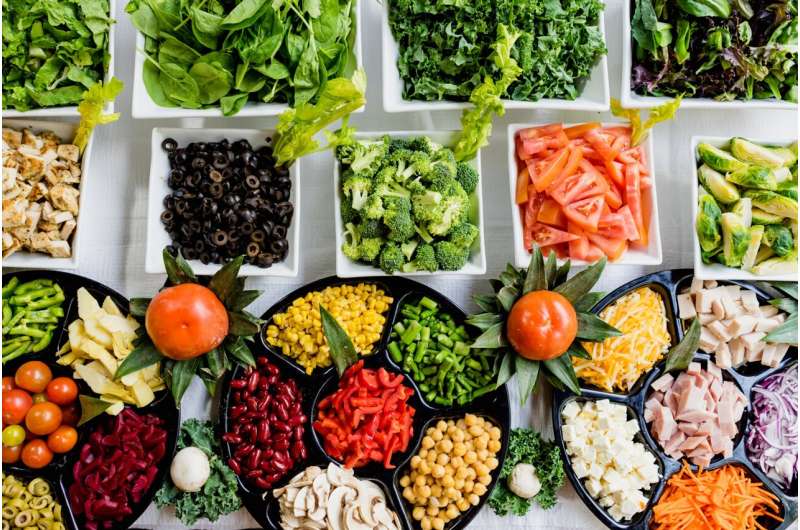This article has been reviewed according to Science X's editorial process and policies. Editors have highlighted the following attributes while ensuring the content's credibility:
fact-checked
peer-reviewed publication
trusted source
proofread
Study: Using Nutrition Facts labels linked to healthier eating choices among 8th and 11th grade students

Using the Nutrition Facts labels to make food choices is significantly associated with healthy eating among 8th and 11th grade students in Texas, although the proportion of students using nutrition labels to make their food choices is low, according to research from UTHealth Houston.
A study led by first author Christopher D. Pfledderer, Ph.D., MPH, assistant professor in the Department of Health Promotion and Behavioral Sciences at UTHealth Houston School of Public Health, and senior author Deanna Hoelscher, Ph.D., RDN, the John P. McGovern Professor in Health Promotion and regional dean of the School of Public Health in Austin, examined the associations between the level of nutrition label usage and healthy or unhealthy eating habits among a statewide sample of eighth- and 11th-graders. Their findings were recently published in Nutrients.
"With recent changes in Nutrition Facts labels, which make them easier to read and comprehend, this is a great example of how higher-level changes in policy and environment can promote positive health behaviors among adolescents," said Pfledderer, who is also a faculty member at the Michael & Susan Dell Center for Healthy Living. "Even something that seems small may have a big impact on health and well-being."
Since 1990, most packaged foods regulated by the U.S. Food and Drug Administration have nutrition labels, also known as Nutrition Facts labels, which provide information about serving size, calories, and nutrients including calcium, fiber, total fat, cholesterol, and sodium. In 2016, the Nutrition Facts label was updated to display serving sizes and calories in a larger and bolder font, require added sugars to be included in grams and a percent daily value, and reflect newer scientific information, including information about the link between diet and chronic diseases. The information can be used to help consumers compare food items and potentially make healthier food choices.
Researchers analyzed cross-sectional associations between the Nutrition Facts label use and eating behaviors among a state representative sample of students who completed the 2019-2020 Texas School Physical Activity and Nutrition (SPAN) Survey. Students self-reported their level of nutrition label usage to make food choices and previous day consumption of 26 food items, including 13 healthy foods and 13 unhealthy foods. The 26 food items were used to calculate a SPAN Healthy Eating Index score (0-100), a Healthy Foods Index Score (0-100), and an Unhealthy Foods Index score (0-100).
Overall, 11% of students reported always or almost always using nutrition labels to make food choices, and nearly 28% reported sometimes using them. Conversely, 61% indicated they never or almost never used nutrition labels to make food choices. The average SPAN Healthy Eating Index score among students in the sample ranged from 41.8 to 53.6.
Nutrition Facts label usage was significantly and positively associated with SPAN Healthy Eating and Healthy Food Index scores, and significantly and negatively associated with Unhealthy Foods Index score.
Students who reported using nutrition labels always or almost always to make food choices had significantly higher odds of consuming healthy foods, including baked meat, nuts, brown or whole grain bread, vegetables, whole fruit, and yogurt. They also had significantly lower odds of consuming unhealthy foods, including chips, cake, candy, and soda, compared to students who reported never or almost never using the Nutrition Facts label.
The research team says public health efforts should be made to improve nutrition literacy and encourage nutrition label use among secondary students in the U.S.
"This study suggests an opportunity for school-based nutrition education or social media campaigns aimed at secondary students," said Hoelscher, who is also director of the Michael & Susan Dell Center for Healthy Living. "Teaching students about nutrition label use can help improve dietary intake, which is important for the prevention of chronic diseases both now and in the future."
Co-authors of the study include Nalini Ranjit, Ph.D.; Adriana Perez, Ph.D.; Raja I. Malkani; Augusto Cesar Ferreira De Moraes, MSc, Ph.D.; Ethan T. Hunt, Ph.D., MPH; and Carolyn L. Smith, all with UTHealth Houston School of Public Health.
More information: Christopher D. Pfledderer et al, Using the Nutrition Facts Label to Make Food Choices Is Associated with Healthier Eating among 8th and 11th-Grade Students: An Analysis of Statewide Representative Data from the 2019–2020 Texas School Physical Activity and Nutrition Survey, Nutrients (2024). DOI: 10.3390/nu16020311





















